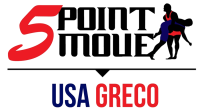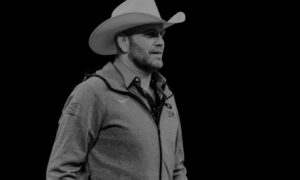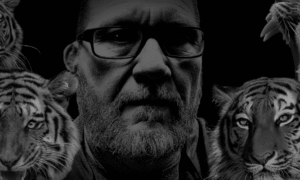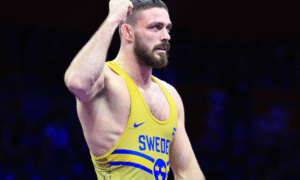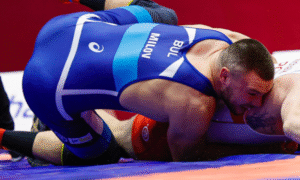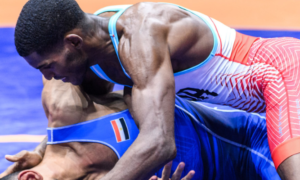Five Point Move is proud to host US Greco Roman National Team Head Coach Matt Lindland every week for “Coach Lindland’s Report.” For fans and wrestlers looking for insights regarding the US Greco National Team, we ask Coach Lindland some questions to get his take on training and upcoming competitions. If you have any questions you’d like us to ask going forward let us know via Facebook, Twitter, or through our Contact page.
This week, Coach Lindland is preparing for the Silver Coaches Clinic, where he, along with several other US Greco Roman coaches, will be giving a presentation. The conversation then moves to his hectic schedule over the next couple of months, RaVaughn Perkins’s injury, and potential participants at the non-Olympic Trials. Most of all, YOUR feedback is part of the process this time around, as Coach Lindland responds to user questions.
5PM: You have the Silver Coaches Clinic tomorrow, which also includes a Greco Roman panel discussion. What are you going to be talking about and also, who exactly is on the panel?
Coach Matt Lindland: The Silver Coaches College is part of the USA Wrestling Coaches Education Week. We know that every coach out there needs to get their Bronze cards and get certified so they can have their floor passes for the events. But there is a lot of interest, especially since Mike Clayton has taken over the program, really autonomizing things and getting everything up online, making USA Wrestling more “tekkie.” He’s been converting a lot of coaches and helping them with their education and I am really grateful he has consistently included Greco Roman as part of the coaches education plan. Plus, he works really great with my staff. So, Mike asked us to teach one of the wrestling sessions, and Mohamed and I are going to go over that series that we actually put up on YouTube just a couple of weeks ago where I covered the three ways to do an arm throw, a spin, a shoulder throw. I don’t know what they call it. I call it a “flying mare”, but it’s where you take the gravity out from underneath your opponent. Step underneath their center of gravity. There are three unique ways to do the technique and taking the athletes through those different principles and letting them get creative in figuring out how each one works best for them. And just creating a reaction.
It’s the same thing for Mohamed. He showed three distinct ways to do a bodylock, he quarter-turns to the underhook side, or he steps underneath to a sag bodylock, or the guy steps out and he quarter-turns to the trapped-arm side. All three different techniques from the same position. We posted those videos up on YouTube a couple of weeks ago and we’re going to go over that again. Because last year, I think we covered a lot on how to control underhooks and two-on-one’s and scoring from those positions. But the rules have changed and I want coaches thinking about teaching how to throw and score big four-pointer’s. We’re going to cover those areas in our technical seminar.
And yeah, we’ve got an opportunity to do a Greco Roman panel. Our team leader for the last quad, Kiki Kelly, is going to be in town. We’re actually going to have a nice meal afterwards. She is going to come out and be a part of that. Andy Bisek will be here, Spenser Mango will represent the WCAP, Mohamed will be a part of the panel, also. Chris Saba is out of town, he’s in Buffalo watching a football game. TC (Dantzler) and Herb House will be a couple of our other volunteer coaches who will be here. I think the message we’re trying to share with these coaches is the same thing we’ve been talking about in our weekly reports here, and that is how to engage these younger athletes.
Imagine if each coach out there across the country identified one athlete that they said, You know what, this guy is a Greco prospect, I am going to help him follow that path, and they send him our way. We’d probably find that 3% just off of every coach sending us one athlete. I mean, you look at guys like TC, who I’ve got four of his wrestlers in my room training daily. You know, it’s pretty incredible that one coach went out there and said, Here’s the need. These guys need more athletes, and then went out and found guys who he inspired to wrestle Greco. The only one who is not out of high school is Jordan Martinez, the other three are out of high school but started with us while they were still in high school. So I think that is the direction our program is definitely starting to move in. I know that from having meetings with the USOC and sharing that vision with them, Terry Steiner was on the exact same page. That’s why I think our schedules are starting to sync up a lot more. You’ll probably see Greco and the women doing a lot more coordinated schedules than freestyle because of their need for the NCAA system, or their tolerance of it, rather. They’ll probably stick with the real traditional schedule of nothing happening until after March.
5PM: With the panel, will this be in a question and answer format?
ML: Yeah, I think each individual will get an opportunity to present anything they want. I’ll probably run through a quick presentation that I’ve shared at other coaches colleges I’ve been at. I can do a mat piece and a presentation piece with this. I’ll do a presentation piece and I’ll get on the mat after, as well. But I will have that hour with the coaches and then I’ll have a separate time. But yeah, there will be a lot of questions and answers, I hope that it’s very interactive.
5PM: When you get out of the clinic tomorrow, you’re heading over to Kansas City. What is going on out there?
ML: Oh well, our sports psychologist who works with our team, Jack Stark, is also the sports psychologist for Hendricks Motorsports. I met Jack when I was an athlete at the University of Nebraska and we remained friends and in contact since the early ‘90’s, 1991. I just respect Jack and when I got this job, he actually reached out to me and was like, Let me know if you need help. He was one of the first calls I got. I got a lot of those calls from people like TC, Chris Saba, and Herb House, countless people who said, This is a volunteer organization, USA Wrestling, how can I help Team USA? It’s incredible I have those kinds of people out there.
Jack was one of the first who reached out to me and has been working with our program since I came on board, but he was working with Hendricks. That was the only paid job he’s ever been in because his background is in clinical psychology, but that could be pretty stressful. I think you kind of take a lot of that work home with you because you’re dealing with people and you’re seeing people struggle daily, and it’s hard on you. So I think that was when Jack kind of got out of the clinical side for a bit, just to take a break and do some sports stuff. When I met him he was working with Tom Osbourne, and that was when they were really good (laughs). They won three national titles in that time frame. I’m very confident in Jack’s abilities, so when he asked us to join him at NASCAR, Momir and I jumped at the opportunity to go out there and be a part of the event. I mean, we’re down there in the pits, we’re going to be hanging with the team for dinner on Saturday. Tanner Andrews, one of our Northern Michigan athletes, will actually be working that day. He’s one of the tire changers for Hendricks, so we’ll get the chance to see Tanner in action.
5PM: Oh wow, I hadn’t heard he was doing that.
ML: Yup, there are a lot of opportunities for retired wrestlers if they want to get into that because these guys are athletes and have coaches. Ironically enough, it’s like you’re going to NASCAR and you meet the pit coach for Joe Gibbs. Like, Oh, you’re the coach for the guys who change the tires, unscrew lug nuts, and put gas in the car? Okay. I told him I was coming out to that race and he said, “Come on by and said ‘hi.’” So now I know people from Hendricks and Joe Gibbs Racing, and I’ve never watched a NASCAR event in my life. But I’m looking forward to it, though I think it will be very hard to watch NASCAR races or car races in the future when you get the kind of experience where you’re down there in the pits and hanging with the coaches. It’ll be a lot harder. It’s a lot like when I was fighting, my sponsor, Sportsbook.com, also sponsored Mayweather and when I’d go watch fights with Sportsbook, I’d sit next to Roy Jones (laughs). It’s kind of hard to watch fights up in the stands after that.
5PM: Ah, you mean you get spoiled.
ML: (Laughs) You get spoiled when you’re sitting on the apron next to Roy Jones while he’s commentating, for sure. And then the next day you’re up in the 30th row in the stands or something like, This is not the same! It’s not the same feel!

5PM: News came out last week that RaVaughn Perkins still has a back issue and will not be competing at the non-Olympic Trials. How big of a blow is this and how is he doing with the situation?
ML: Since he posted it on his social media, I’m comfortable talking about his situation. It’s something we’ve known he’s been dealing with for quite some time. When he was competing in Mongolia to qualify the weight, the guy couldn’t sit down all day. He’d wrestle a match and stay standing. The only time he’d get off his feet was if he was lying down and we had someone massaging his back. We couldn’t figure out what was wrong with him for the longest time and when we got the X-ray, we noticed he had a small fracture that has to heal. It really just takes time. You’ve got to rest that and the rest period is extensive. And you know how these wrestlers are, they think they are invincible, they think they are resting and doing some light pummeling but next thing you know, they’re throwing someone with a headlock and re-tweaking it. Rest sometimes means staying off the mat. I know it’s hard for these guys, that’s what they do their whole lives, they’re athletes. He got some really bad news that it wasn’t healing because he wasn’t able to rest it properly, so now we’re being really strict with this because we want to get him back as soon as we can and get him healthy and strengthen it up.
The really good news is that it is going to heal, he’s got some really good bone density, and he’s young, he’s healthy. He just needs to not move his back, which essentially means do not wrestle, do not lift weights, don’t exercise, really, to tell the truth. He just needs to rest it and heal.
5PM: Could he be back by say, December?
Coach Matt Lindland: Hmmm, I don’t think he’ll be back by December. He’d already obviously be qualified for the Trials having made our Olympic Team and medaling in international tournaments last year. I don’t think that is as big of a priority for him as much as taking the time necessary to get that healed right and being prepared for the big ones, which are the Trials in April and the World Championships.
5PM: With RaVaughn being out, that’s one athlete for sure who won’t be at the Farrell Trials in November. But do you have any kind of informal list or idea yet of who will be going?
ML: I think I have a pretty good idea of who is going to be showing up to qualify. Definitely RaVaughn being out changes things for the fans out there. They want to see him, they love his story, they want to see him compete and be successful, he’s an exciting fighter. But we’ve got some other really talented guys at 66 kilos, 75, and 71 who are all going to find their way up or down. If I’m looking at it, you can’t count Ellis Coleman out or Alex Sancho. Pat Smith is probably standing out. But you also have guys like Chris Gonzalez, who is a very capable athlete. Some younger guys like Austin Morrow, Anthony Linares, who are still up at Northern Michigan, young guys who are first or second-year Senior athletes. They are probably not favorites to win that, but still, very talented guys. I think Cody Pack is an interesting guy. He just came out of the college system in South Dakota, moved himself out to Colorado Springs, and he’s really good. He is surprisingly adapting very fast. The two athletes who have come out here since the Olympic Games are Mason Manville and Cody, and both guys are on an accelerated learning path right now. You can just see them improving on a daily basis. That’s who is at 71.
We could also discuss 80 kilos. I think you’re looking at some 85 kilo guys who are 80 kilo guys. Cheney (Haight) is 80, but he found a spot at 75. (Patrick) Martinez went up to 85, but he was our World Team member last year in 2015 at 80, so I think he’s definitely a favorite. But Jon Anderson is definitely in the mix, Kendrick Sanders is back, and then we have some younger guys there, too. Kamal Bey is probably going up to 80, Jesse Porter, Manville… So you have some very exciting matches and we’ll have to see how it all shakes out.
5PM: Highlighting your schedule is always important just because, it gives fans an idea of how busy you actually are. There is just so much travel…
ML: Oh boy…
5PM: Right, and coming up over the next two and half months, you’re not going to be in one place too long.
ML: No, I wish I was here in Colorado Springs more. It’s why you coach wrestling, to work with athletes and be on the mat with them. But pretty much everywhere I’m going I am getting the opportunity to work with coaches and athletes, and I see the value of working with coaches. When you have 60 or 70 coaches, and it sounds like some of these seminars it might be even bigger than that, it’s great because each one of these coaches has the opportunity to impact athletes by sharing the message, sharing what we’re trying to do and the direction the Greco Roman program is going, and that is just as important as being on the mat. It’s just that I like to be home. I like to walk from my house every morning to the Olympic Training Center to coach athletes. But there is a lot more that goes into this role than going to wrestling practice.
So yeah, after I get back from Kansas City, I’ll be here in Colorado and then I head out to Indiana for the coaches clinic on the 21st. That evening, I actually fly out to Minneapolis for a mini-camp with the Minnesota Storm for the 22nd, and then we have the Hall of Fame banquet that evening. So we’ll have two pretty solid workouts on that Saturday with the Storm guys, they are bringing in some new recruits. I am going to have the chance to meet some new Greco guys. Romero Cotton, they have a DII national champion I’m looking forward to meeting, just some of the new guys that the Storm has been bringing into their program.
I get back from that Sunday and I’ll see my wife. But that Monday I’m heading out to Boise to see Ivan (Ivanov) and meet some of his athletes and just get the chance to work with Ivan for a couple of days. Then in November, there is a clinic I heard is huge, a couple of hundred high school coaches in Wisconsin. Next will be South Dakota. Cody Pack, one of our athletes who I talked about earlier, his father runs a camp out there and apparently, it’s a really nice facility. He has offered that up to us for developmental camps and even some Senior camps.
But when we’re talking about Juniors, I’m not thinking of those guys as developmental athletes, I see them as our near future. These guys are going to be part of us for 2020. When you think about it, you go, What is it going to take for us to get what the freestyle had this year? It was two medals, and I think we’re looking for more than that. But you’ve got to think, where was Kyle Snyder four years ago? He was a Cadet. Where was J’Den Cox? He was a Cadet. This narrative we’ve been talking about makes sense — Why are we not ultra-focused on these younger athletes? And not so much in a developmental aspect, more in that we have to prepare these guys to compete at the highest level. Because we know you can take a Cadet and four years later, he can be an Olympic champion. That’s proven. It’s about getting people out there to see that.
Getting out there to South Dakota to work with these athletes is nice but also, to see the facilities that we could use for camps is exciting, too. And then we head right into the Bill Farrell, New York City, and I’ll get a chance to see you out there. Then come home and the real travel begins two weeks later going to Baku for the Golden Grand Prix and I’ll be taking some of those guys from the Grand Prix to the World Championships or the Clubs Cup two weeks after that in Budapest. So we’ll do some training in Hungary and we will get back and have our Nationals in December.
5PM: And then you’ll be able to breathe out.
ML: Then I’ll take a big sigh and say, “Gosh, that was a long run.” (Laughs) Maybe I’ll go to Portland to see my kids or fly them out here to Colorado, do something. I should definitely get together with our kids.
5PM: Let’s hit on some questions from readers. The first one, coming from Facebook, Keith asks, “My son is 8 and wrestles folkstyle but has shown a strong interest in Greco. What is a good age to have him start practicing and competing in Greco?”
Coach Matt Lindland: I think that is a great question. We’ve covered it before, but it’s something that probably needs to be talked about a lot. USA Wrestling has a long-term development model that I think we’ve got to get familiar with and look at the age groups we’re talking about with our athletes. From five to eight years old, you don’t have a style. You’re not wrestling folkstyle, you’re just getting on the mat playing if you’re doing things right. You’re wrestling two to three times a week. We’re not trying to burn young kids out, we’re trying to get them excited about the sport. They are doing fun activities, they are playing games. Maybe the games have movements which are wrestling-based. They are doing tumbling like in gymnastics, but they are playing. They are getting positions and learning how to control their bodies because before you can control someone else’s body, which is what wrestling is, putting someone else’s body where you want them to go, you have to be able to control your own body. So I would say start with Greco, don’t start with folkstyle, but we live in America so most coaches are going to be showing that traditional folkstyle path. I would focus on the basic skills and the last two basic skills are probably the two we use the most in Greco, the back-step and the back arch, and they are the two most neglected by most coaches.

USA Wrestling Athlete Development Model
I’ve told this story before and I’ll probably tell it again this weekend at the coach’s conference, but I had a three-time All American from a Division I program come out to give Greco a try and continue competing. And he’d pick a guy up by the body and ask, “What do I do?” Well, any damn thing you want. You’re controlling him and his feet are off the mat. Just arch. “But I’ve never done that.” You never arched in your life? Okay, you’re a three-time All-American. Ten minutes later, I was able to have the guy throwing his opponents. We started with some wall walks and some drills, some dummies, and next thing you know, he’s throwing. It works. I was like, See, it’s easy. We got into another situation where I was like, Just back-step and hit that. “What’s a back-step?” Oh my gosh! You were at a four-year university that has actually produced Greco Roman Olympians, Olympic medalists, and World medalists, and you don’t know a back-step and a back arch. (Laughs)
So I think focusing on those basic skills for that age group is so critical. And of course, I’d like to see all of those young athletes wrestle Greco if that is what he is enjoying and gravitating towards. Help him find coaches because that is what you need. If it wasn’t for the coaches who were involved in my life, I would have never been able to do what I did. I didn’t do what I did on my own. It was because of my club coaches, my high school club I wrestled at, my college coaches who encouraged me to wrestle Greco, and ultimately, the coaches I worked with at the Senior level. But I was really fortunate — I had some really good coaches and you have to seek those out sometimes.
5PM: Okay, this next one is sort of a two-parter from Instagram courtesy of Oldfatbrokedown (nice name!) and says “We believe in the message Coach Lindland puts out. There are kids out there who want to do Greco & not folk/freestyle. They/we are a silent but active minority.” That’s an interesting perspective. Do you think there are a lot of kids out there who are more into Greco than folkstyle but aren’t being heard from?
ML: I certainly think there is a minority of athletes out there who enjoy Greco more than the other styles. We’ve seen those guys. They are the guys on our National Team or making Junior World Teams. But yeah, it’s just really hard here because there is not a lot of coaches who teach the classic style of wrestling. They are out there, we just have to seek them out, we have to find them. That is part of the plan like we talked about, is putting this network of coaches together so we can continue to educate other coaches and inspire these guys. But there are guys out there, there is Lucas Steldt, JD Robbins, Mark Halovorson, guys who are focused really on just Greco. And then some of our coaches are in a situation where their livelihoods depend on them teaching folkstyle certain months out of the year, but the rest of the time they do see the value in keeping their guys wrestling and having fun doing it, and they use Greco Roman for that. Their athletes enjoy the style and have fun participating in it. Plus, these coaches’ egos aren’t caught up in their athletes winning state titles, they are looking to put wrestlers on World and Olympic Teams, helping them find the podium at the Olympic Games.
That is where their hearts are and it is what they want to do. We’re on the same mission. Those guys are out there, I just don’t think there is enough of them. What was the second part?
5PM: The second part was very simple — How about some par terre defense content?
ML: Is he talking about video stuff on par terre defense?
5PM: It would seem so.
ML: Okay, I think you had another question like that and I can address both at the same time. I think they are both comments from coaches or are folks who are just supportive of athletes pursuing the style they are interested in, which is Greco Roman. And to answer them both is, we’re doing it. I was hired two years ago in the middle of a quad and my goal was to help our guys win medals at the Olympic Games and the World Championships over the last two years. And I’ve been slowly getting content out. You’ll see that I’ve released some stuff on the Coach Matt Lindland YouTube channel, two videos went up and we’ll have another one up this week. And then at the coaches’ clinic, I will re-shoot that whole series on the bodylock and the arm drags.
We’ll keep it getting it out there, guys. We’ll keep putting it out there, just understand that I’m a wrestling coach, not a film editor. I’m doing this stuff on my phone with an app. I’m putting practice plans together, I’m going in there, either I’m teaching, Mohamed’s teaching or Momir is teaching. And in the midst of that, we have to stop and think, We’ve got to share this content. (Laughs) We’re working on that, I actually just got a really nice video camera with a boom mic on it. Darryl Weber had asked me to share some MMA videos with him and apparently felt I needed a better camera, so he sent that out. I’m getting the right equipment and learning how to edit, but we’re a volunteer organization and if you’re looking to help and have a skill-set for this and want to put some content on tape, we can do that.
But we are getting it out. We’ve talked about the need to do it. I’ve shown over the last couple of weeks we’re getting content out there and it will continue to flow. I made a commitment to the coaches and athletes of the United States. It won’t just be me and my staff, we will also film stuff at international camps and bring it back. But you are right, there isn’t as big of a market as the folkstyle, so they aren’t as well-produced and aren’t going to sell because we haven’t hit our 3% yet.
5PM: Okay, next one is Twitter and from Cody Arnold (@CodyOcho5), who asks “Where do you see Dylan Ness’s future in Greco?”
ML: Cody, I don’t know if you know, but Dylan is rehabbing due to shoulder surgery right now, so he won’t be competing at the NYAC and I haven’t yet received a report on when we can expect him back. I hope it’s soon, he is a very talented athlete. He’s explosive, exciting, and I think taking forced par terre out of the equation definitely helps Dylan. He gets on top, though. He’s been there, he has a reverse lift. I think he can take it as far as he wants. He has a health issue, he needs to get healthy and see how durable he is, for sure. I know his brother does some Greco with the Storm guys, but also wrestles freestyle. That’s another athlete we’d like to see come over.
But I really don’t know with Dylan where he ends up in the mix. I think it’s too early to tell, but I am sure excited to have him as part of the program.
5PM: The last one is kind of a catch-all. You already touched on this but I’m going to ask it anyway. From Twitter, user “Jamie” (@jamiebelk) asks, “How can we see Greco have the same success that freestyle is having at the Senior and Junior levels?”
Coach Matt Lindland: Well first off, I don’t think we get the same numbers freestyle does. In this country, we probably have the best system in the world for wrestling, but we wrestle the wrong style. Freestyle’s skills are very close to folkstyle’s, so the athletes have a little easier of a time transferring their skills over. When you get folkstyle athletes who are ready to transition over to Greco, you have to break a lot of bad habits. We teach a lot of skills and they have to develop, retain, and master those skills to be successful.
So I think what it is going to take is more coaches, but what we’re talking about is how we build this from the ground up. I’m working from the top down at the National level, these are the guys I’ve got and I have to get our elite athletes to the next level, which is winning World and Olympic medals. Then we have to work from the bottom up and say, Okay, how can we get a lot of athletes? Well, we need a lot of coaches. And so, we’re going to start with ten. And from those ten coaches, we’re going to hold regional events where they are going to bring their athletes together with another ten coaches from all over those areas. We’ve got some really hot pockets in the United States where guys do practice Greco. I mean, you look at Illinois, Wisconsin, and Minnesota and those states pretty much border each other. They are all close enough to where they can hold weekend mini-camps together, so we’re looking at breaking up those regions and getting those athletes together with their coaches and then really educating the coaches so they can take that information and knowledge back with their athletes to help us build this up. We just need guys wrestling the right style, that’s what it is going to take.
Be sure to follow Coach Matt Lindland on Facebook, Twitter, and his official blog for updates on the US Greco Roman Wrestling program heading into the new competitive cycle.
